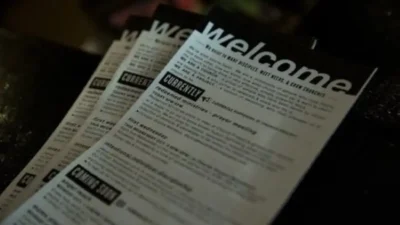For us as Christians, every day is Thanksgiving Day. There’s nothing wrong with all of us setting aside such a day once a year to shine a light on our need to be thankful, but we should never do that blindly, and we would do well to tell the truth about this day, and then after telling that truth, to remake it as we can into something that truly befits what we are called to be and do in our thankfulness.
Bishop Rickel shares his reflections this Thanksgiving and his wishes for a Happy Thanksgiving to each of you.
Please accept YouTube cookies to play this video. By accepting you will be accessing content from YouTube, a service provided by an external third party.
If you accept this notice, your choice will be saved and the page will refresh.
An Indigenous Peoples’ History of the United States
Today in the United States, there are more than five hundred federally recognized Indigenous nations comprising nearly three million people, descendants of the fifteen million Native people who once inhabited this land. The centuries-long genocidal program of the US settler-colonial regimen has largely been omitted from history. Now, for the first time, acclaimed historian and activist Roxanne Dunbar-Ortiz offers a history of the United States told from the perspective of Indigenous peoples and reveals how Native Americans, for centuries, actively resisted expansion of the US empire.
With growing support for movements such as the campaign to abolish Columbus Day and replace it with Indigenous Peoples’ Day and the Dakota Access Pipeline protest led by the Standing Rock Sioux Tribe, An Indigenous Peoples’ History of the United States is an essential resource providing historical threads that are crucial for understanding the present. In An Indigenous Peoples’ History of the United States, Dunbar-Ortiz adroitly challenges the founding myth of the United States and shows how policy against the Indigenous peoples was colonialist and designed to seize the territories of the original inhabitants, displacing or eliminating them. And as Dunbar-Ortiz reveals, this policy was praised in popular culture, through writers like James Fenimore Cooper and Walt Whitman, and in the highest offices of government and the military. Shockingly, as the genocidal policy reached its zenith under President Andrew Jackson, its ruthlessness was best articulated by US Army general Thomas S. Jesup, who, in 1836, wrote of the Seminoles: “The country can be rid of them only by exterminating them.”
Spanning more than four hundred years, this classic bottom-up peoples’ history radically reframes US history and explodes the silences that have haunted our national narrative.
An Indigenous Peoples’ History of the United States is a 2015 PEN Oakland-Josephine Miles Award for Excellence in Literature.
This Land Is Their Land
Ahead of the 400th anniversary of the first Thanksgiving, a new look at the Plymouth colony’s founding events, told for the first time with Wampanoag people at the heart of the story.
In March 1621, when Plymouth’s survival was hanging in the balance, the Wampanoag sachem (or chief), Ousamequin (Massasoit), and Plymouth’s governor, John Carver, declared their people’s friendship for each other and a commitment to mutual defense. Later that autumn, the English gathered their first successful harvest and lifted the specter of starvation. Ousamequin and 90 of his men then visited Plymouth for the “First Thanksgiving.” The treaty remained operative until King Philip’s War in 1675, when 50 years of uneasy peace between the two parties would come to an end.
400 years after that famous meal, historian David J. Silverman sheds profound new light on the events that led to the creation, and bloody dissolution, of this alliance. Focusing on the Wampanoag Indians, Silverman deepens the narrative to consider tensions that developed well before 1620 and lasted long after the devastating war-tracing the Wampanoags’ ongoing struggle for self-determination up to this very day.
This unsettling history reveals why some modern Native people hold a Day of Mourning on Thanksgiving, a holiday which celebrates a myth of colonialism and white proprietorship of the United States. This Land is Their Land shows that it is time to rethink how we, as a pluralistic nation, tell the history of Thanksgiving.
Thanksgiving Day
Thanksgiving Day is a national holiday and day of thanks. Thanksgiving Day is celebrated in the United States on the fourth Thursday in November. This custom is based on the celebration of three days of prayer and feasting by the Plymouth, Massachusetts, colonists in 1621. There was also a Thanksgiving celebration with prayer by members of the Berkeley plantation, near what is now Charles City, Virginia, in 1619.
The first national Thanksgiving Day was celebrated in 1789. Under President Abraham Lincoln, Thanksgiving Day came to be celebrated annually on the last Thursday of November. Thanksgiving Day was celebrated on the third Thursday of November in the three years 1939-1941 under President Franklin D. Roosevelt. However, the Thanksgiving Day commemoration was moved back to the fourth Thursday in November by Congress in 1941.
Thanksgiving Day is a major holy day and a national day in the Prayer Book calendar of the church year (pp. 16-17, 33). The Proposed Prayer Book of 1786 included “A Form of Prayer and Thanksgiving to Almighty God, for the Fruits of the Earth, and all the other Blessings of his merciful Providence.” The first American Prayer Book (1789) replaced the four national days of the 1662 English book with propers [lessons and collect of the day] for Thanksgiving Day.
The collect for Thanksgiving Day gives thanks to God the Father for the fruits of the earth in their season and for the labors of those who harvest them. It asks that we may be faithful stewards of God’s great bounty, providing for our own necessities and the relief of all who are in need (BCP, p. 246).
Hymns for Thanksgiving Day in The Hymnal 1982 include “Praise to God, immortal praise” (Hymn 288), “Come, ye thankful people, come” (Hymn 290), and “We plow the fields, and scatter” (Hymn 291). The Hymnal 1982 Accompaniment Edition, Vol. 1, provides musical settings for a “Litany of Thanksgiving for a Church” (S 391; see BCP, pp. 578-579) and a “Litany of Thanksgiving” (S 392; see BCP, pp. 836-837). The Litany of Thanksgiving may be used on Thanksgiving Day in place of the prayers of the people at the Eucharist, or at any time after the collects at Morning or Evening Prayer, or separately.
Taken from Thanksgiving Day.
The Collect for Thanksgiving Day
Almighty and gracious Father, we give you thanks for the fruits of the earth in their season and for the labors of those who harvest them. Make us, we pray, faithful stewards of your great bounty, for the provision of our necessities and the relief of all who are in need, to the glory of your Name; through Jesus Christ our Lord, who lives and reigns with you and the Holy Spirit, one God, now and for ever. Amen.
A Litany of Thanksgiving
For optional use on Thanksgiving Day, in place of the Prayers of the
People at the Eucharist, or at any time after the Collects at Morning or
Evening Prayer, or separately.
Let us give thanks to God our Father for all his gifts so
freely bestowed upon us.
For the beauty and wonder of your creation, in earth and
sky and sea.
We thank you, Lord.
For all that is gracious in the lives of men and women,
revealing the image of Christ,
We thank you, Lord.
For our daily food and drink, our homes and families, and
our friends,
We thank you, Lord.
For minds to think, and hearts to love, and hands to serve,
We thank you, Lord.
For health and strength to work, and leisure to rest and play,
We thank you, Lord.
For the brave and courageous, who are patient in suffering
and faithful in adversity,
We thank you, Lord.
For all valiant seekers after truth, liberty, and justice,
We thank you, Lord.
For the communion of saints, in all times and places,
We thank you, Lord.
Above all, we give you thanks for the great mercies and
promises given to us in Christ Jesus our Lord;
To him be praise and glory, with you, O Father, and the
Holy Spirit, now and for ever. Amen.

Bishop Greg Rickel
The Rt. Rev. Gregory H. Rickel was elected bishop on May 12, 2007, and became the eighth Bishop of Olympia in September 2007. He embraces radical hospitality that welcomes all, no matter where they find themselves on their journey of faith. He envisions a church that is a safe and authentic community in which to explore God’s infinite goodness and grace as revealed in the life and continuing revelation of Jesus Christ.
Church of the Redeemer
Welcome to Church of the Redeemer: Worshiping God, living in community, and reaching out to the world. We are an Episcopal Church serving north King County and south Snohomish County, Washington. As you travel your road, go with friends walking the way of Jesus at Redeemer.
Church of the Redeemer is at 6210 Northeast 181st Street in Kenmore, Washington. We are a short distance north of Bothell Way, near the Burke-Gilman Trail. The entrance looks like a gravel driveway. The campus is larger on the inside than it is on the outside. And we managed to hide a large building on the side of a hill that is not easily seen from the street.
The Episcopal Church welcomes you.





